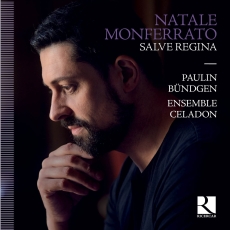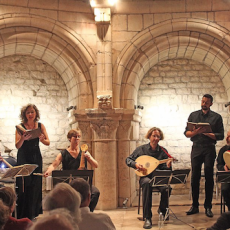Ensemble Céladon - Monferrato: Salve Regina - Fanfare
I doubt many have actually heard of Natale Monferrato (1603–1685), but he held an important position in Venice at St. Mark’s for the bulk of his career, making him, at least in the period, one of the leading lights of sacred music in Italy. He was probably educated there, likely under Claudio Monteverdi and Giovanni Rovetta, the latter who appointed him as his assistant. When Rovetta succeeded to the post of maestro di cappella in 1643, it was assumed that Monferrato would be next in line, but in 1668 when Rovetta died, the position went to Francesco Cavalli, the noted opera composer. Although he eventually became maestro di cappella in 1676, one should not feel too sorry for him. He was an excellent director of the choir and, moreover, functioned as a teacher at the Ospedale dei Mendicanti, both of which allowed him to achieve a grand reputation.
As the choir director, Monferrato was diligent in composing music for St. Mark’s, but also he like so many others began to publish the works in sets. This disc takes a sampling of nine solo motets for alto voice and continuo from the 1666 publication. The first of these motets, Sic ergo Jesu, begins in a quasi-recitative style, solemn and pious, but soon Monferrato inserts some chromatic moments, where the harmony is diffuse and the line meanders. At the end of the first section it dies away on the words “perish” and “die.” It then becomes more animated, with a heavy tread in the continuo line, before returning to the slow chromaticism. As a sacramentary motet it is exquisite, as well as highly emotional. The second, Ad sonos, is brighter and trips along almost merrily. After a brief recitative, the pace continues, but this time with some challenging vocal coloratura. The Alleluia is quite filled with energy, though it vanishes in an instant. The Regina cæli continues the celebratory tone, with a dance line opening. When the intercession (Ora pro nobis) occurs, the pace slows to a reflective moment before the Alleluia returns with roulades that seem more secular than sacred. On the other hand, the Salve Regina begins with a somber organ introduction, which moves carefully through the harmonic centers in a way that seems natural but without excessive chromaticism. The voice enters above a drone bass, an invocation that is simple, effective, and powerful. As it moves through the various portions of the text, word painting is used to outline the various moods, and at the end there is certain implacableness to the march rhythm, before the prayerful final section of solemn reflection. The Jubilate Deo opens with jubilation, outlined through some cheerful dance rhythms, and these sequence through a section that runs freely in the vocal line, while it jaunts right along to the conclusion. Of the remainder, the Popera Domine has a running bass line that offers counterpoint to the voice, also moving right along in a frenetic pace. The final work is the Clamo ad te, where the opening mezze di voce sustains a static mood. The bass line here also walks along, but the vocal line appears a bit more strophic, but here Monferrato inserts some careful but often tortuous coloratura.
These are fine compositions, indicating that the composer’s reputation was well deserved. They are cohesive, interesting in the musical patterns as well as text painting, and have a finely tuned sense of harmony. The performance by the Céladon ensemble is excellent. The continuo group provides the perfect foil for the sonorous countertenor of Paulin Bündgen. His variation of tempos provides the necessary life, making these motets far more than just documentary. This is a fine disc, with excellent performances and the sort of integrated musical structure that one will find intriguing.

